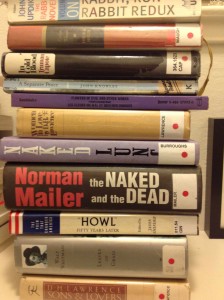Title: Naked Lunch
Published: 1959
Author: William Burroughs
Challenge status: Naked Lunch is #73 on Radcliffe Publishing Course Top 100 Novels of the 20th Century, and frequent target of banning attempts (frequently challenged classics) according to the ALA’s Office for Intellectual Freedom. Book #39 on Summer of Banned Books ’13.
Why: Labeled as obscenity in Boston, MA Superior Court (1965), the following year the decision was reversed by the State Supreme Court. The book was originally published in Paris (1959), but a U.S. version wasn’t published until 1962, purportedly due to concern over U.S. obscenity laws – Naked Lunch was one of the most recent books to be tried as obscenity. Here’s an excerpt from the transcript of the Boston trial Mailer & Ginsberg are interviewed/deposed. Sounds like the California case (the book was also censored in Los Angeles) ended up getting overturned w/out going to trial. In Australia, it was banned by Customs after an imported copy was seized and labeled as ‘hard-core pornography’ (Port Adelaide, 1960); it was released from the prohibited list in 1973.
First line: ”I can feel the heat closing in, feel them out there making their moves, setting up their devil doll stool pigeons, crooning over my spoon and dropper I throw away at Washington Square Station, vault a turnstile and two flights down the iron stairs, catch and uptown A train…Young, good looking, crew cut, Ivy League, advertising exec type fruit holds the door back for me.”
Synopsis:
Welp, so, how to describe this without “spoiling” any of it? Let’s start with this: Naked Lunch is the most disgusting book I’ve ever read. I’m trying to decide if it’s also the most disturbing. Difficult to say, I’ve read a lot of disturbing books.
What does that mean? Reading it is kind of like having a really graphic, vivid nightmare of drowning, and as you struggle to wake up, someone is firmly holding you under. I can see what all the fuss was about with the censors, if ever there was a book that needed a trigger warning, it’s this one. I wasn’t looking forward to it, having several years watched quite a bit of a movie adaptation (I think now it was the Cronenberg one, but I’m not eager to confirm).
The study of thinking machines teaches us more about the brain than we can learn by introspective methods. Western man is externalizing himself in the form of gadgets. – William S Burroughs, Naked Lunch











